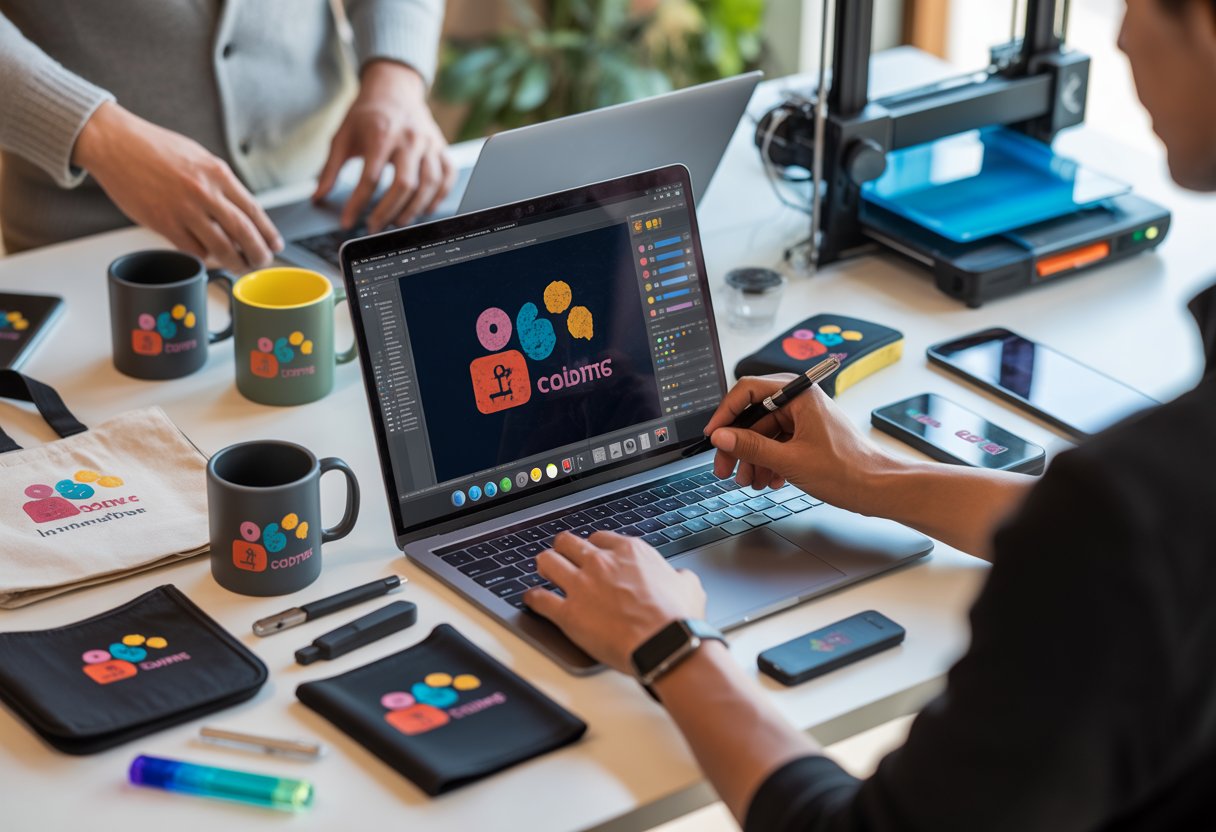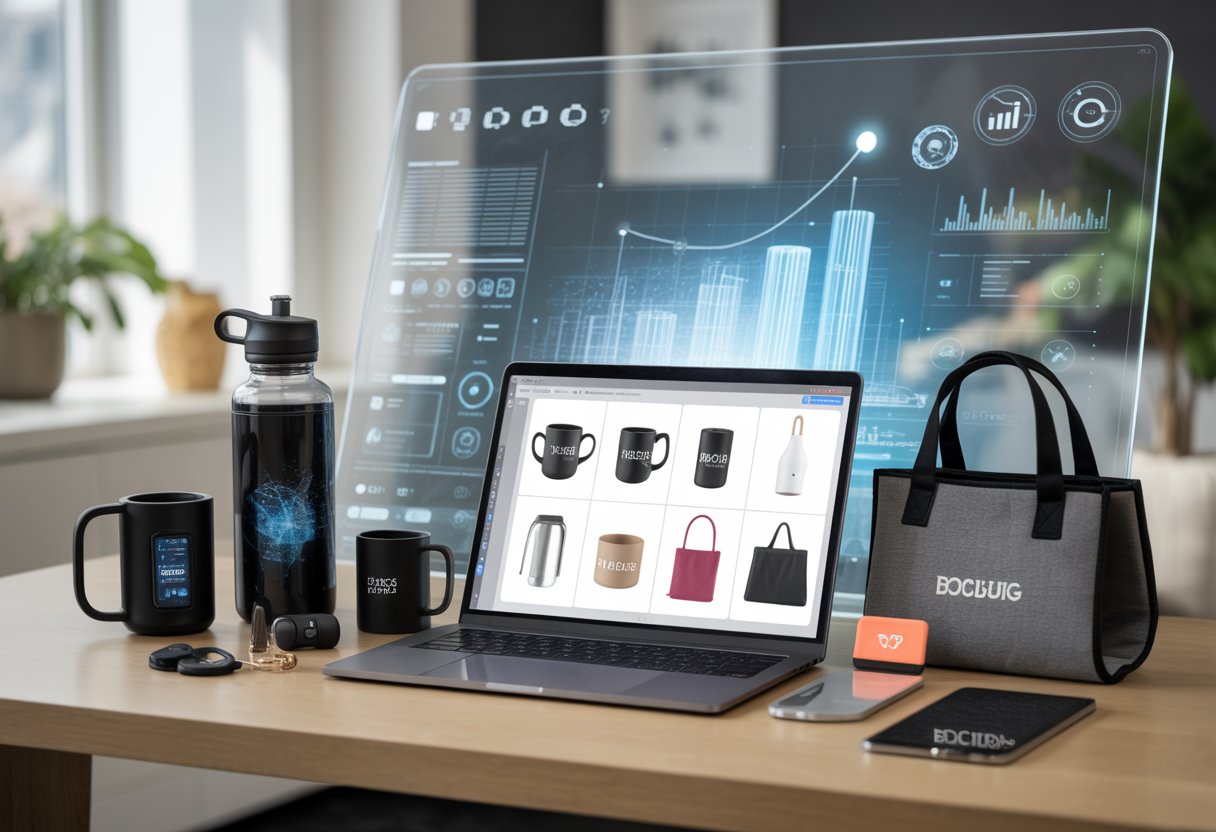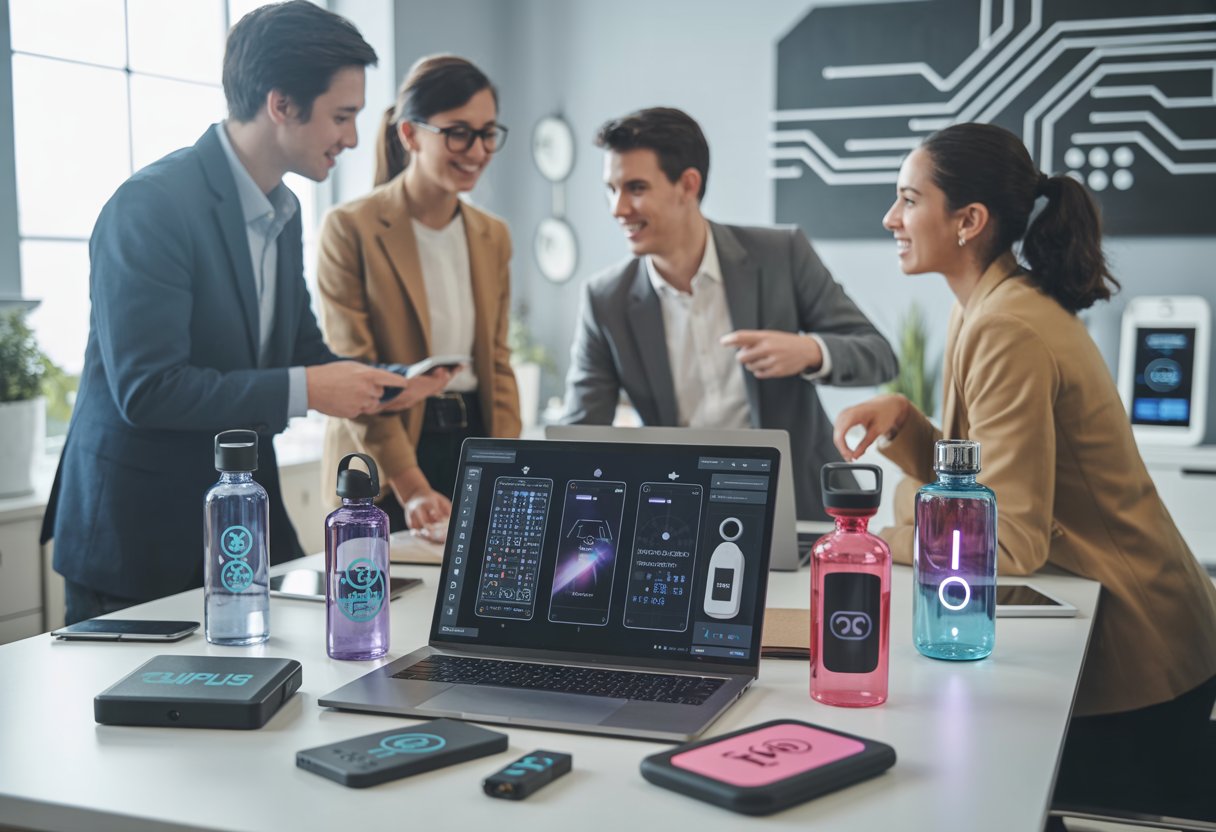Promotional products have transformed from simple branded pens and mugs into sophisticated marketing tools that seamlessly blend physical items with digital experiences. Modern businesses increasingly recognise that traditional promotional strategies must evolve to meet the demands of tech-savvy consumers who expect personalised, interactive, and sustainable marketing solutions.

Technology now serves as the backbone of effective promotional product campaigns, enabling brands to create deeper connections with their audiences through smart integration, data-driven insights, and innovative user experiences. Nearly half of consumers now prefer promotional products that connect to digital content or apps, highlighting a significant shift towards digitally-enhanced marketing materials that offer tangible value beyond simple brand visibility.
This digital transformation encompasses everything from augmented reality product previews to smart technology integration, fundamentally changing how brands approach promotional marketing. The convergence of sustainability concerns, personalisation demands, and technological capabilities has created unprecedented opportunities for businesses to create meaningful brand interactions that resonate with modern consumers whilst delivering measurable results.
The Evolution of Technology in Promotional Products

Technology has fundamentally transformed promotional products from simple branded items into sophisticated marketing tools that create interactive experiences and deeper customer connections. The internet revolutionised distribution and targeting strategies whilst tech gadgets became powerful promotional instruments.
From Traditional to Digital: A Brief History
Promotional products began in the late 1800s with basic branded calendars, bags, and hats. Companies quickly discovered these items improved customer loyalty and brand recognition. By the mid-20th century, the market expanded to include pens, mugs, T-shirts, and keychains.
These traditional items were popular because they were:
- Functional and used regularly
- Affordable for mass distribution
- Effective at keeping brands visible
The digital age changed everything. Companies needed to stand out in a saturated market filled with standard promotional items. Technology offered new possibilities for creating memorable experiences beyond simple branded goods.
QR codes emerged as the first major digital integration. Companies could link physical products to digital content, exclusive offers, or interactive features. A branded water bottle could now connect users to wellness tips or product information.
NFC technology followed, allowing instant communication between promotional items and smartphones. Event badges and wristbands became interactive tools for sharing contact information and accessing digital content.
Emergence of Tech Gadgets as Promotional Tools
USB drives were among the first tech-based promotional items to gain widespread adoption. They offered practical value whilst providing branding opportunities. Today, power banks have become essential promotional tools as people rely heavily on mobile devices.
Popular tech promotional items include:
- Bluetooth speakers and headphones
- Fitness trackers and smartwatches
- Smart home gadgets like plugs and lights
- Portable chargers and wireless charging pads
These items appeal to tech-savvy consumers and offer higher perceived value than traditional promotional products. Wearable tech particularly excels at daily brand exposure, as users interact with fitness trackers and smartwatches throughout the day.
Smart home gadgets represent the cutting edge of promotional technology. Branded smart plugs and Wi-Fi-enabled devices link companies with modern, forward-thinking values. These products provide ongoing utility whilst maintaining brand visibility.
The shift towards tech gadgets reflects changing consumer expectations. People expect promotional items to offer genuine value and functionality rather than simply displaying a logo.
Influence of the Internet on Promotional Product Strategy
The internet transformed how companies approach promotional product campaigns. Online platforms enabled precise targeting and personalised distribution strategies. Companies could track engagement and measure return on investment more effectively.
Digital integration features include:
- Augmented Reality (AR) experiences through smartphone apps
- App connectivity for ongoing customer engagement
- Data collection through digital interactions
- Personalisation based on user preferences
Social media amplified the impact of promotional products. Recipients share photos and experiences online, extending brand reach beyond the initial recipient. Companies began designing products specifically for social media visibility.
E-commerce integration allows promotional items to connect directly to online stores. QR codes on products can lead to exclusive discounts or product catalogues, bridging physical and digital shopping experiences.
The internet enabled real-time customisation of promotional products. Companies can now create personalised items based on customer data and preferences, making each product feel unique and relevant.
Sustainability concerns driven by online awareness pushed companies towards eco-friendly promotional tech. Solar-powered chargers and recycled materials became important selling points for environmentally conscious consumers.
Tech-Savvy Promotional Product Innovations

Modern technology has transformed promotional products into powerful marketing tools that blend utility with innovation. Smart devices, wireless accessories, and portable tech gadgets now dominate corporate gifting strategies whilst creating meaningful connections with recipients.
Smart Devices: Fitness Trackers and Wearable Tech
Fitness trackers have become highly sought-after promotional items that combine health awareness with brand visibility. Companies across industries now distribute branded fitness bands that monitor steps, heart rate, and sleep patterns.
These wearable devices offer exceptional value because recipients use them daily. The constant interaction keeps brands top-of-mind whilst providing genuine utility to users.
Popular promotional wearables include:
- Basic fitness trackers with step counting
- Heart rate monitoring devices
- Smart watches with customisable faces
- Activity bands with sleep tracking
Wellness companies particularly benefit from fitness tracker promotions. They can demonstrate their commitment to health whilst showcasing their technological sophistication.
The personalisation aspect makes these items especially effective. Recipients often view customised fitness trackers as thoughtful gifts rather than standard promotional materials.
Popular Tech Gadgets: USB Drives and Power Banks
USB drives remain essential promotional products despite cloud storage growth. They offer practical storage solutions whilst providing prominent branding opportunities through custom shapes and colours.
Modern promotional USB drives feature enhanced security, faster transfer speeds, and creative designs. Companies often shape them to match their products or industry themes.
Power banks have emerged as particularly valuable promotional items. They address universal smartphone charging needs whilst offering substantial branding space.
Key features driving popularity:
- High-capacity charging capabilities
- Multiple device compatibility
- Compact, portable designs
- LED indicators and displays
These gadgets prove especially effective at trade shows and conferences. Recipients immediately recognise their practical value and typically retain them for extended periods.
The combination of utility and visibility makes USB drives and power banks excellent promotional investments.
Wireless Chargers and Bluetooth Accessories
Wireless charging technology has revolutionised promotional product offerings. Branded wireless chargers provide convenient charging solutions whilst maintaining continuous brand exposure on desks and nightstands.
These devices appeal to tech-savvy audiences who value convenience and modern functionality. The sleek designs complement contemporary office environments.
Bluetooth accessories represent another growing category. Branded speakers, headphones, and earbuds offer premium promotional opportunities with extended usage periods.
Popular Bluetooth promotional items:
- Portable speakers with custom branding
- Wireless earbuds in branded cases
- Bluetooth-enabled desk accessories
- Smart speakers with voice activation
The audio quality and battery life of these products directly impact brand perception. Companies must balance cost considerations with quality expectations to maintain positive associations.
Wireless promotional products demonstrate technological leadership whilst providing genuine value to recipients.
Personalisation and Customisation Through Technology
Modern technology has transformed how businesses create personalised promotional products, enabling precise customisation at scale and making unique items accessible for campaigns of any size. Digital printing advances, sophisticated messaging systems, and on-demand production capabilities now allow companies to deliver tailored products that resonate with individual recipients.
Advances in Digital Printing
Digital printing technology has revolutionised promotional product customisation by offering unprecedented precision and flexibility. Unlike traditional screen printing, digital methods can produce full-colour designs with intricate details and photographic quality.
Variable data printing enables businesses to create unique designs for each recipient. This technology allows companies to print different names, images, or messages on each product within a single production run.
Modern digital printers can handle complex colour gradients and fine text with remarkable accuracy. The technology supports various materials including fabric, metal, plastic, and paper products.
Print-on-demand capabilities have eliminated minimum order quantities that once made personalisation expensive. Businesses can now order single customised items cost-effectively.
UV printing and sublimation techniques have expanded customisation options to include curved surfaces, textured materials, and previously difficult-to-print items like phone cases and water bottles.
Personalised Messaging and Slogans
Technology-driven personalisation systems allow businesses to create targeted messaging that speaks directly to individual recipients. Advanced software can generate personalised slogans, taglines, and content based on customer data and preferences.
Dynamic messaging platforms pull information from customer databases to create relevant content. These systems can incorporate recipient names, locations, job titles, or purchase history into promotional messages.
Artificial intelligence helps generate contextually appropriate messaging at scale. The technology analyses customer behaviour patterns to suggest messaging that resonates with specific demographics or interests.
Multi-language customisation has become seamless through automated translation and localisation tools. Companies can efficiently create promotional products with region-specific messaging whilst maintaining brand consistency.
Smart templating systems enable marketing teams to create personalised campaigns without extensive design knowledge. These platforms offer pre-designed layouts that automatically adjust for different text lengths and content types.
On-Demand and Short-Run Production
On-demand production technology has eliminated the need for large inventory investments whilst enabling rapid customisation. Companies can now produce personalised promotional products as needed, reducing waste and storage costs.
Digital workflows connect ordering systems directly to production equipment. This integration allows automatic processing of personalised orders without manual intervention.
Short-run production capabilities make personalised campaigns viable for small businesses and targeted campaigns. Technology enables cost-effective production of quantities as low as single units.
Real-time tracking systems provide visibility throughout the production process. Customers can monitor their personalised orders from design approval through delivery.
Cloud-based production networks allow businesses to access manufacturing capabilities globally. This technology enables local production near end customers, reducing shipping times and costs for personalised items.
Automated quality control systems ensure consistent output across personalised products. These technologies check each item for print quality, colour accuracy, and proper personalisation before dispatch.
Integrating AR and QR Codes in Promotional Campaigns
QR codes create instant access to digital content from physical promotional materials, whilst augmented reality transforms static marketing into immersive brand experiences. These technologies work together to bridge the gap between offline and online engagement through interactive campaigns.
Utilising QR Codes for Interactive Experiences
QR codes serve as digital bridges that connect physical promotional products to interactive online content. Companies can embed these codes on packaging, brochures, business cards, and event materials to unlock exclusive experiences.
Key applications include:
- Virtual product demonstrations
- Behind-the-scenes content access
- Contest entries and competitions
- Social media integration
- Customer feedback collection
The technology eliminates download barriers since users simply scan codes with their smartphone cameras. This accessibility increases engagement rates compared to traditional promotional methods.
Dynamic QR codes offer particular advantages for promotional campaigns. Marketers can update destination content without reprinting materials and track valuable data including scan locations, timing, and device types.
Businesses often integrate QR codes into email campaigns, social media posts, and trade show materials. A restaurant might place codes on table tents linking to digital menus, whilst retailers use them on product packaging for instructional videos.
The measurable nature of QR codes allows companies to assess campaign effectiveness through real-time analytics.
Augmented Reality for Enhanced Brand Engagement
Augmented reality overlays digital content onto the physical world, creating memorable promotional experiences that traditional marketing cannot match. AR technology transforms static promotional materials into interactive storytelling platforms.
Popular AR promotional applications:
- Virtual try-on experiences for fashion and beauty products
- 3D product visualisation in customer environments
- Interactive brand storytelling through packaging
- Gamified experiences at events and trade shows
The technology works through smartphone cameras, making it accessible without specialised equipment. Companies like Nike and Sephora have successfully implemented AR experiences that allow customers to visualise products before purchasing.
AR promotional campaigns generate higher engagement rates because they encourage active participation rather than passive viewing. Users spend more time interacting with brands and are more likely to share experiences on social media.
The combination of QR codes and AR creates powerful promotional tools. Customers scan QR codes to instantly access AR experiences, eliminating app downloads and reducing friction in the customer journey.
Data Analytics and Insights from Tech-Enabled Promotional Products
Smart promotional products now generate detailed usage data and engagement metrics that help brands measure campaign effectiveness. Companies can track user behaviour patterns and optimise their promotional strategies based on real-time insights.
Tracking Usage and Engagement
Tech-enabled promotional products provide comprehensive data on how customers interact with branded items. Smart water bottles track daily usage patterns, whilst fitness trackers monitor step counts and activity levels. These insights reveal which promotional products generate the most engagement.
Digital promotional products collect metrics such as:
- Active usage hours per day
- Feature utilisation rates across different functions
- User retention periods after initial activation
- Geographic usage patterns through location data
Businesses can monitor engagement through mobile apps connected to promotional items. QR codes on promotional products link to digital platforms that track scan rates and subsequent actions. This data shows whether recipients actually use the items or simply store them away.
Companies gain insights into customer preferences by analysing usage patterns. High engagement rates indicate successful product choices, whilst low usage suggests the need for different promotional strategies. These metrics help brands understand which demographics respond best to specific promotional products.
Leveraging Data for Campaign Optimisation
Promotional analytics enable companies to refine their marketing strategies using concrete data rather than assumptions. Brands can identify which promotional products drive the highest return on investment and adjust their campaigns accordingly.
Data-driven insights reveal optimal timing for promotional campaigns. Usage patterns show when customers are most likely to engage with branded items, allowing companies to schedule distribution for maximum impact. Seasonal trends become apparent through consistent data collection.
Companies can personalise future promotional campaigns based on individual user behaviour. If data shows a customer frequently uses fitness-related promotional products, brands can target similar items to that demographic. This targeted approach increases campaign effectiveness.
Key optimisation strategies include:
- Adjusting product quantities based on usage data
- Modifying promotional timing to match peak engagement periods
- Selecting product types that generate higher interaction rates
- Targeting specific demographics with proven engagement patterns
Real-time data allows for immediate campaign adjustments. If usage metrics show declining engagement, companies can quickly pivot their promotional strategies to maintain customer interest.
Sustainability, User Experience, and the Future of Technology in Promotion
Modern promotional products increasingly integrate sustainable materials with advanced technology to create more meaningful user experiences. These developments are reshaping how brands connect with consumers whilst addressing environmental concerns.
Eco-Friendly and Innovative Material Choices
Promotional products now utilise biodegradable electronics and sustainable materials alongside traditional items. Companies are incorporating recycled plastics into tech accessories like wireless chargers and Bluetooth speakers.
Plant-based circuit boards are emerging in promotional electronics. These boards use materials derived from agricultural waste rather than traditional fibreglass.
Smart promotional products feature low-energy consumption designs. LED-powered items use solar panels or kinetic energy harvesting to reduce battery waste.
| Sustainable Material | Application | Environmental Benefit |
|---|---|---|
| Bamboo composites | Phone cases, USB drives | Biodegradable within 2-3 years |
| Recycled ocean plastic | Bluetooth speakers | Removes 15-20 bottles per item |
| Cork leather | Tech accessories | Renewable harvest every 9 years |
Digital sustainability practices reduce the carbon footprint of promotional campaigns. QR codes replace printed materials, directing users to digital content instead of physical brochures.
Enhancing User Interaction and Brand Loyalty
Technology in promotion creates personalised experiences that adapt to individual user preferences. Smart promotional products collect usage data to tailor future brand interactions.
AI-driven personalisation allows promotional items to learn user habits. Branded fitness trackers adjust recommendations based on activity patterns, strengthening brand connection.
Interactive promotional products use augmented reality features. Users scan branded items with their phones to unlock exclusive content or experiences.
Hyper-personalisation through promotional technology increases engagement rates by 40-60%. Products that respond to user behaviour create stronger emotional connections than static items.
Omni-channel integration ensures promotional products work across multiple touchpoints. A branded smart device might sync with email campaigns, social media, and in-store experiences.
Voice-activated promotional items respond to user commands. These products serve functional purposes whilst maintaining brand visibility in users’ daily routines.



